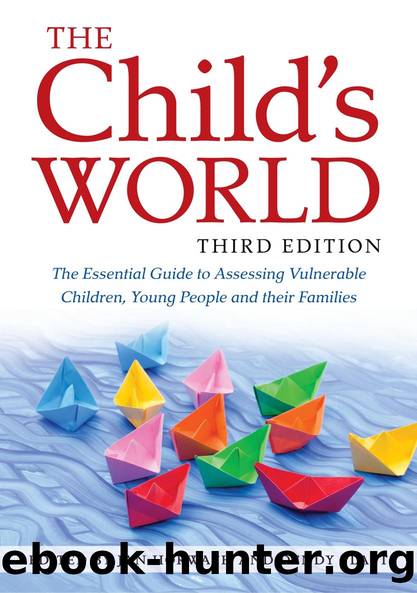The Child's World, Third Edition by Jan Horwath Dendy Platt

Author:Jan Horwath, Dendy Platt [Jan Horwath, Dendy Platt]
Language: eng
Format: epub
ISBN: 9781784503826
Barnesnoble:
Publisher: Kingsley, Jessica Publishers
Published: 2018-12-06T00:00:00+00:00
Child-centred assessments
Professionals completing assessments may not have personal life experience of the damage and debilitating effects of abuse or neglect on a child, and so they may have some difficulty understanding them. It is important, therefore, that they familiarise themselves with the possible impact of maltreatment. They should also consider the impact of living with issues such as family violence, alcohol or other substance abuse, or mental illness, as described in Chapter 12. This insight should assist in the attempt of the member of staff to put themselves into the position of the child rather than the adult. For staff to begin to understand the day-to-day experience of the child it is important that the focus is firmly placed upon the child, whose account is of paramount importance. The views of the parent must also be considered, but not at the expense of the childâs. It is important that the setting is a listening school or college and that staff use and hone their skills in this area to accurately hear and understand the life experience of the child.
This point is well made in the serious case review following the death of Daniel Pelka (Lock 2013). Professionals working with Daniel relied on the word of his mother rather than considering what it was like to be Daniel living in that household. It would have been preferable for them to talk to Daniel and his sibling to discuss his experiences rather than rely on their mother to tell them. Simple questions such as âDid you have tea last night?â, âWhere do you sleep?â and âWhat did you do before you went to sleep last night?â can easily be included in the whole-class experience in a morning news slot, and would have given a clearer picture of what Danielâs life was like without singling him out. Table 16.1 considers expected behaviours against a chronological or developmental stage and some behaviours which may cause concern. It is necessary to be aware of the parameters of expected behaviours in order to make an informed comparison. The table is intended to complement the information provided in Chapter 14 on child development.
Table 16.1 Assessing educational needs by age and stages of development
Download
This site does not store any files on its server. We only index and link to content provided by other sites. Please contact the content providers to delete copyright contents if any and email us, we'll remove relevant links or contents immediately.
The Secret History by Donna Tartt(18849)
The Social Justice Warrior Handbook by Lisa De Pasquale(12142)
Thirteen Reasons Why by Jay Asher(8796)
This Is How You Lose Her by Junot Diaz(6794)
Weapons of Math Destruction by Cathy O'Neil(6146)
Zero to One by Peter Thiel(5686)
Beartown by Fredrik Backman(5599)
The Myth of the Strong Leader by Archie Brown(5425)
The Fire Next Time by James Baldwin(5249)
How Democracies Die by Steven Levitsky & Daniel Ziblatt(5128)
Promise Me, Dad by Joe Biden(5087)
Stone's Rules by Roger Stone(5026)
A Higher Loyalty: Truth, Lies, and Leadership by James Comey(4845)
100 Deadly Skills by Clint Emerson(4840)
Rise and Kill First by Ronen Bergman(4704)
Secrecy World by Jake Bernstein(4646)
The David Icke Guide to the Global Conspiracy (and how to end it) by David Icke(4625)
The Farm by Tom Rob Smith(4437)
The Doomsday Machine by Daniel Ellsberg(4416)
